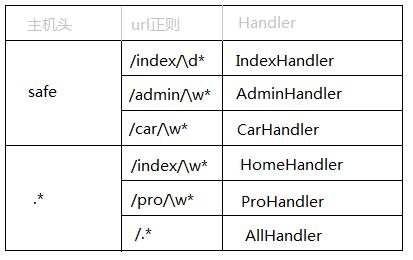Python Web 框架:Tornado
Posted
tags:
篇首语:本文由小常识网(cha138.com)小编为大家整理,主要介绍了Python Web 框架:Tornado相关的知识,希望对你有一定的参考价值。
参考技术A输入命令:
备注:
Tornado应该运行在类Unix平台,为了达到最佳的性能和扩展性,仅推荐Linux和BSD(充分利用Linux的epoll工具和BSD的kqueue达到高性能处理的目的)
python-Tornado 框架
概述
Tornado 是 FriendFeed 使用的可扩展的非阻塞式 web 服务器及其相关工具的开源版本。这个 Web 框架看起来有些像web.py 或者 Google 的 webapp,不过为了能有效利用非阻塞式服务器环境,这个 Web 框架还包含了一些相关的有用工具 和优化。
Tornado 和现在的主流 Web 服务器框架(包括大多数 Python 的框架)有着明显的区别:它是非阻塞式服务器,而且速度相当快。得利于其 非阻塞的方式和对 epoll 的运用,Tornado 每秒可以处理数以千计的连接,这意味着对于实时 Web 服务来说,Tornado 是一个理想的 Web 框架。我们开发这个 Web 服务器的主要目的就是为了处理 FriendFeed 的实时功能 ——在 FriendFeed 的应用里每一个活动用户都会保持着一个服务器连接。(关于如何扩容 服务器,以处理数以千计的客户端的连接的问题,请参阅 C10K problem。)
下载安装:
|
1
2
3
4
|
pip3 install tornado源码安装https://pypi.python.org/packages/source/t/tornado/tornado-4.3.tar.gz |
框架使用
一、快速上手
|
1
2
3
4
5
6
7
8
9
10
11
12
13
14
15
16
17
18
19
|
#!/usr/bin/env python# -*- coding:utf-8 -*- import tornado.ioloopimport tornado.web class MainHandler(tornado.web.RequestHandler): def get(self): self.write("Hello, world") application = tornado.web.Application([ (r"/index", MainHandler),]) if __name__ == "__main__": application.listen(8888) tornado.ioloop.IOLoop.instance().start() |
执行过程:
- 第一步:执行脚本,监听 8888 端口
- 第二步:浏览器客户端访问 /index --> http://127.0.0.1:8888/index
- 第三步:服务器接受请求,并交由对应的类处理该请求
- 第四步:类接受到请求之后,根据请求方式(post / get / delete ...)的不同调用并执行相应的方法
- 第五步:方法返回值的字符串内容发送浏览器

#!/usr/bin/env python
# -*- coding:utf-8 -*-
#!/usr/bin/env python
# -*- coding:utf-8 -*-
import tornado.ioloop
import tornado.web
from tornado import httpclient
from tornado.web import asynchronous
from tornado import gen
import uimodules as md
import uimethods as mt
class MainHandler(tornado.web.RequestHandler):
@asynchronous
@gen.coroutine
def get(self):
print \'start get \'
http = httpclient.AsyncHTTPClient()
http.fetch("http://127.0.0.1:8008/post/", self.callback)
self.write(\'end\')
def callback(self, response):
print response.body
settings = {
\'template_path\': \'template\',
\'static_path\': \'static\',
\'static_url_prefix\': \'/static/\',
\'ui_methods\': mt,
\'ui_modules\': md,
}
application = tornado.web.Application([
(r"/index", MainHandler),
], **settings)
if __name__ == "__main__":
application.listen(8009)
tornado.ioloop.IOLoop.instance().start()
二、路由系统
路由系统其实就是 url 和 类 的对应关系,这里不同于其他框架,其他很多框架均是 url 对应 函数,Tornado中每个url对应的是一个类。
|
1
2
3
4
5
6
7
8
9
10
11
12
13
14
15
16
17
18
19
20
21
22
23
24
25
26
27
28
29
30
31
|
#!/usr/bin/env python# -*- coding:utf-8 -*- import tornado.ioloopimport tornado.web class MainHandler(tornado.web.RequestHandler): def get(self): self.write("Hello, world") class StoryHandler(tornado.web.RequestHandler): def get(self, story_id): self.write("You requested the story " + story_id) class BuyHandler(tornado.web.RequestHandler): def get(self): self.write("buy.wupeiqi.com/index") application = tornado.web.Application([ (r"/index", MainHandler), (r"/story/([0-9]+)", StoryHandler),]) application.add_handlers(\'buy.wupeiqi.com$\', [ (r\'/index\',BuyHandler),]) if __name__ == "__main__": application.listen(80) tornado.ioloop.IOLoop.instance().start() |
Tornado中原生支持二级域名的路由,如:

三、模板引擎
Tornao中的模板语言和django中类似,模板引擎将模板文件载入内存,然后将数据嵌入其中,最终获取到一个完整的字符串,再将字符串返回给请求者。
Tornado 的模板支持“控制语句”和“表达语句”,控制语句是使用 {% 和 %} 包起来的 例如 {% if len(items) > 2 %}。表达语句是使用 {{ 和 }} 包起来的,例如 {{ items[0] }}。
控制语句和对应的 Python 语句的格式基本完全相同。我们支持 if、for、while 和 try,这些语句逻辑结束的位置需要用 {% end %} 做标记。还通过 extends 和 block 语句实现了模板继承。这些在 template 模块 的代码文档中有着详细的描述。
注:在使用模板前需要在setting中设置模板路径:"template_path" : "tpl"
1、基本使用

#!/usr/bin/env python
# -*- coding:utf-8 -*-
import tornado.ioloop
import tornado.web
class MainHandler(tornado.web.RequestHandler):
def get(self):
self.render("index.html", list_info = [11,22,33])
application = tornado.web.Application([
(r"/index", MainHandler),
])
if __name__ == "__main__":
application.listen(8888)
tornado.ioloop.IOLoop.instance().start()

<!DOCTYPE html>
<html>
<head>
<meta http-equiv="Content-Type" content="text/html; charset=UTF-8"/>
<title>老男孩</title>
<link href="{{static_url("css/common.css")}}" rel="stylesheet" />
</head>
<body>
<div>
<ul>
{% for item in list_info %}
<li>{{item}}</li>
{% end %}
</ul>
</div>
<script src="{{static_url("js/jquery-1.8.2.min.js")}}"></script>
</body>
</html>

在模板中默认提供了一些函数、字段、类以供模板使用:
escape: tornado.escape.xhtml_escape 的別名
xhtml_escape: tornado.escape.xhtml_escape 的別名
url_escape: tornado.escape.url_escape 的別名
json_encode: tornado.escape.json_encode 的別名
squeeze: tornado.escape.squeeze 的別名
linkify: tornado.escape.linkify 的別名
datetime: Python 的 datetime 模组
handler: 当前的 RequestHandler 对象
request: handler.request 的別名
current_user: handler.current_user 的別名
locale: handler.locale 的別名
_: handler.locale.translate 的別名
static_url: for handler.static_url 的別名
xsrf_form_html: handler.xsrf_form_html 的別名
2、母版

<!DOCTYPE html>
<html>
<head>
<meta http-equiv="Content-Type" content="text/html; charset=UTF-8"/>
<title>老男孩</title>
<link href="{{static_url("css/common.css")}}" rel="stylesheet" />
{% block CSS %}{% end %}
</head>
<body>
<div class="pg-header">
</div>
{% block RenderBody %}{% end %}
<script src="{{static_url("js/jquery-1.8.2.min.js")}}"></script>
{% block JavaScript %}{% end %}
</body>
</html>

{% extends \'layout.html\'%}
{% block CSS %}
<link href="{{static_url("css/index.css")}}" rel="stylesheet" />
{% end %}
{% block RenderBody %}
<h1>Index</h1>
<ul>
{% for item in li %}
<li>{{item}}</li>
{% end %}
</ul>
{% end %}
{% block JavaScript %}
{% end %}
3、导入

<div>
<ul>
<li>1024</li>
<li>42区</li>
</ul>
</div>

<!DOCTYPE html>
<html>
<head>
<meta http-equiv="Content-Type" content="text/html; charset=UTF-8"/>
<title>老男孩</title>
<link href="{{static_url("css/common.css")}}" rel="stylesheet" />
</head>
<body>
<div class="pg-header">
{% include \'header.html\' %}
</div>
<script src="{{static_url("js/jquery-1.8.2.min.js")}}"></script>
</body>
</html>
4、自定义UIMethod以UIModule
a. 定义

# uimethods.py
def tab(self):
return \'UIMethod\'

#!/usr/bin/env python
# -*- coding:utf-8 -*-
from tornado.web import UIModule
from tornado import escape
class custom(UIModule):
def render(self, *args, **kwargs):
return escape.xhtml_escape(\'<h1>wupeiqi</h1>\')
#return escape.xhtml_escape(\'<h1>wupeiqi</h1>\')
b. 注册

#!/usr/bin/env python
# -*- coding:utf-8 -*-
#!/usr/bin/env python
# -*- coding:utf-8 -*-
import tornado.ioloop
import tornado.web
from tornado.escape import linkify
import uimodules as md
import uimethods as mt
class MainHandler(tornado.web.RequestHandler):
def get(self):
self.render(\'index.html\')
settings = {
\'template_path\': \'template\',
\'static_path\': \'static\',
\'static_url_prefix\': \'/static/\',
\'ui_methods\': mt,
\'ui_modules\': md,
}
application = tornado.web.Application([
(r"/index", MainHandler),
], **settings)
if __name__ == "__main__":
application.listen(8009)
tornado.ioloop.IOLoop.instance().start()
c. 使用

<!DOCTYPE html>
<html>
<head lang="en">
<meta charset="UTF-8">
<title></title>
<link href="{{static_url("commons.css")}}" rel="stylesheet" />
</head>
<body>
<h1>hello</h1>
{% module custom(123) %}
{{ tab() }}
</body>
四、静态文件
对于静态文件,可以配置静态文件的目录和前段使用时的前缀,并且Tornaodo还支持静态文件缓存。

#!/usr/bin/env python
# -*- coding:utf-8 -*-
import tornado.ioloop
import tornado.web
class MainHandler(tornado.web.RequestHandler):
def get(self):
self.render(\'home/index.html\')
settings = {
\'template_path\': \'template\',
\'static_path\': \'static\',
\'static_url_prefix\': \'/static/\',
}
application = tornado.web.Application([
(r"/index", MainHandler),
], **settings)
if __name__ == "__main__":
application.listen(80)
tornado.ioloop.IOLoop.instance().start()

<!DOCTYPE html>
<html>
<head lang="en">
<meta charset="UTF-8">
<title></title>
<link href="{{static_url("commons.css")}}" rel="stylesheet" />
</head>
<body>
<h1>hello</h1>
</body>
</html>
注:静态文件缓存的实现

def get_content_version(cls, abspath):
"""Returns a version string for the resource at the given path.
This class method may be overridden by subclasses. The
default implementation is a hash of the file\'s contents.
.. versionadded:: 3.1
"""
data = cls.get_content(abspath)
hasher = hashlib.md5()
if isinstance(data, bytes):
hasher.update(data)
else:
for chunk in data:
hasher.update(chunk)
return hasher.hexdigest()
五、cookie
Tornado中可以对cookie进行操作,并且还可以对cookie进行签名以放置伪造。
1、基本操作

class MainHandler(tornado.web.RequestHandler):
def get(self):
if not self.get_cookie("mycookie"):
self.set_cookie("mycookie", "myvalue")
self.write("Your cookie was not set yet!")
else:
self.write("Your cookie was set!")
2、加密cookie(签名)
Cookie 很容易被恶意的客户端伪造。加入你想在 cookie 中保存当前登陆用户的 id 之类的信息,你需要对 cookie 作签名以防止伪造。Tornado 通过 set_secure_cookie 和 get_secure_cookie 方法直接支持了这种功能。 要使用这些方法,你需要在创建应用时提供一个密钥,名字为 cookie_secret。 你可以把它作为一个关键词参数传入应用的设置中:

class MainHandler(tornado.web.RequestHandler):
def get(self):
if not self.get_secure_cookie("mycookie"):
self.set_secure_cookie("mycookie", "myvalue")
self.write("Your cookie was not set yet!")
else:
self.write("Your cookie was set!")
application = tornado.web.Application([
(r"/", MainHandler),
], cookie_secret="61oETzKXQAGaYdkL5gEmGeJJFuYh7EQnp2XdTP1o/Vo=")

def _create_signature_v1(secret, *parts):
hash = hmac.new(utf8(secret), digestmod=hashlib.sha1)
for part in parts:
hash.update(utf8(part))
return utf8(hash.hexdigest())
# 加密
def _create_signature_v2(secret, s):
hash = hmac.new(utf8(secret), digestmod=hashlib.sha256)
hash.update(utf8(s))
return utf8(hash.hexdigest())
def create_signed_value(secret, name, value, version=None, clock=None,
key_version=None):
if version is None:
version = DEFAULT_SIGNED_VALUE_VERSION
if clock is None:
clock = time.time
timestamp = utf8(str(int(clock())))
value = base64.b64encode(utf8(value))
if version == 1:
signature = _create_signature_v1(secret, name, value, timestamp)
value = b"|".join([value, timestamp, signature])
return value
elif version == 2:
# The v2 format consists of a version number and a series of
# length-prefixed fields "%d:%s", the last of which is a
python web框架的介绍
